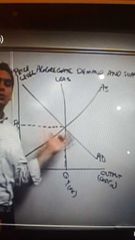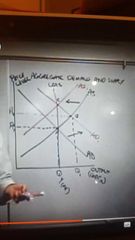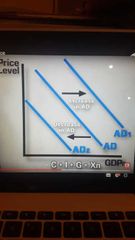![]()
![]()
![]()
Use LEFT and RIGHT arrow keys to navigate between flashcards;
Use UP and DOWN arrow keys to flip the card;
H to show hint;
A reads text to speech;
12 Cards in this Set
- Front
- Back
|
Aggregate demand and supply |
Means adding everything together so this is all the demand and all the supply. Instead of price- Price level is the overall current prices in the economy. Instead of quantity- Real GDP which is the total amount of output in the economy. Downward sloping is aggregate demand, when the price level is high and there is a lot of inflation, people arent going to buy that much, when the price is low, people are going to buy a lot more. Same thing with supply, this is the upward sloping which is called aggregate supply. When a price level is low, producers arent going to produce very much, price level is high, producers are going to produce more. This gives the equilibrium. |
|
|
Long Run Aggregate Supply |

We can see the company is in full employment and the line is the long run aggregate supply. In the long run, an increase in prices will not lead to an increase in output. |
|
|
If Aggregate demand increases |

There is an increase in consumption, the price level increase and the quantity level increase, how do we get to long run. But when demand increases and we are now at a new equilibrium that is inflation. In the long run the prices of resources will increase and the price of resources like labour increases means the aggregate supply curve is going to shift to the left. In the long run, prices of resources will increase when there is inflation. |
|
|
Aggregate Demand |
Aggregate means added all together so the word demand is the demand for everything added all together. We are looking for the demand for everything, cars , boats, toothbrushes, etc. |
|
|
Four componenets of GDP |
Consumer spending, investment spending, government spendinf and net exports (exports minus imports). GDP= C + I + G + Xn. The spending by all the groups added together is aggregate demand. |
|
|
Two reasons for high price level and low quantity demanded and low price level and high quantity demanded. |
One is called the wealth effect and the other is called the interest rate effect. The wealth effect says when the price level goes up and there is an inflation, the value of peoples assets decrease so they buy less stuff, when price level goes down, their money goes further and they have more purchasing power so they will go buy more stuff. The interest rate effect is the idea that the price level goes up there is going to be higher interest rates and with higer interest rates consumption and investment will decrease. |
|
|
Reason why interest rate goes up when price level goes up |
Because people need more money to buy things which mean they are going to borrow things or are going to liquidise their assets because they need more cash. This leads to less money to loan out to other people and so interest rates go up. When price level goes down, interest rates will fall so people will go buy more. |
|
|
Aggregate demand curve |

Like a market demand curve, the aggregate demand curve will also shift. An increse is to the right and decrease to the left. Since aggregate demand is made up of thr four components of GDP (C+I+G+Xn), anything that causes those to change will shift aggregate demand. |
|
|
A significant boom in the stock market |
An increase in the stock market will increase people wealth which means they will have more money so it will increase consumer spending. That would increase and shift our aggregate demand to the right. |
|
|
A decrease in government spending |
Will decrease the aggregate demand, this is government spending on goods and services, this is not included for other stuff that is counted as GDP. A decrease in defence spending will lead to a decrease in aggregate demand. |
|
|
Widespread fear of recession |
If individuals fear a recision they are going to buy less stuff and customer spending will fall and business spending (investment) will also fall so aggregate demand will decrease and shift to the left. |
|
|
Increase in the incomes of a close trading partner |
This means those people will buy more of our stuff so our exports will increase so aggregate demand wi shift to the right. |

